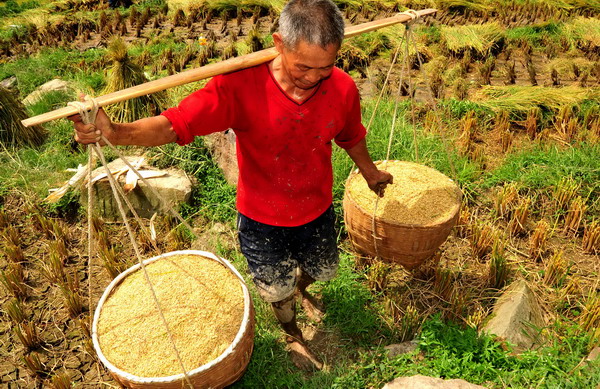Bumper crop, but price still rising
Updated: 2011-09-30 08:09
By Jin Zhu (China Daily)
|
|||||||||||
|
 China's grain output is expected to jump to a record high of more than 550 million tons this year. Even so, prices are expected to rise. [Photo by Yang Shunpi/for China Daily]
|
Grain output is expected to jump to a record high of more than 550 million tons, marking the eighth consecutive year for increased production, Chen Xiaohua, deputy agriculture minister, said at a news conference.
China has been hit by fast-rising grain prices since 2007, which has sparked international concern about the world's biggest grain producer.
"Prices will go up moderately due to higher farm costs, as well as the impact of international markets. But the rise will be limited," Chen said.
The current price rise does not mean the country is suffering from a shortage of grain, he said, adding: "China did import an increased amount of corn last year, but it was mainly due to a price differential that made corn imports attractive."
Official customs statistics show corn imports fell 26.2 percent from January to July this year compared with the same period last year.
"We can basically satisfy the domestic market. Facing the increasing need for corn in the future, the government will make more efforts to balance supply and demand," Chen said.
Since 2007, China's annual grain output has remained above 500 million tons, hitting 546.4 million tons last year, according to the National Bureau of Statistics.
Partly due to global climate change, the country has experienced prolonged and severe droughts, as well as floods, both in northern and southern areas this year.
"Thanks to favorable weather in its major crop-producing areas, as well as effective relief efforts, an increase of grain output this year is still foreseeable," the deputy agriculture minister said.
For example, more than 70 percent of total grain output increase this year is expected to come from Northeast China due to favorable weather conditions, he said.
Chen also said this year's harvest of autumn grain would be good because of expected growth in per-unit yields and enlarged planting areas.
Autumn grain output always accounts for 70 to 75 percent of China's total grain output. As of Monday, about 21.3 million hectares had been reaped, 27.6 percent of the total autumn grain planting area, ministry statistics show.
Meanwhile, on Wednesday, the National Development and Reform Commission, the nation's economic planner, announced it will raise the minimum purchase price for wheat from farmers in 2012.
"The move aims to protect farmers' enthusiasm to grow grain and further stimulate production," Chen said at the news conference.
Lu Bu, a researcher in agricultural resources and regional planning at the Chinese Academy of Agricultural Sciences, said on Thursday that improving the contribution made to grain output by farmers in South China is very important to the future growth of grain output.
"The risk of decreased output is looming, as grain production capacity is now too concentrated in northern areas. When natural disasters hit those areas, the impact will be great," he said.
"The central government needs to encourage farmers in southern areas in crop production, as many of them now prefer to work in the cities for more money, instead of spending time on the land," he said.
The average per-capita income of rural residents was 3,706 yuan ($580) in the first half of this year, a 20.4 increase year-on-year, according to the National Bureau of Statistics.
Related Stories
Grain output to top 550m metric tons 2011 2011-09-29 11:37
China's grain output to hit a record of 550m tons 2011-09-22 17:35
Chinese vice-premier stresses autumn grain production 2011-09-05 09:48
China raises minimum wheat purchase prices 2011-09-29 06:37
Hot Topics
Libya conflict, Gaddafi, Oil spill, Palace Museum scandal, Inflation, Japan's new PM, Trapped miners, Mooncake tax, Weekly photos, Hurricane Irene
Editor's Picks

|

|

|

|

|

|







